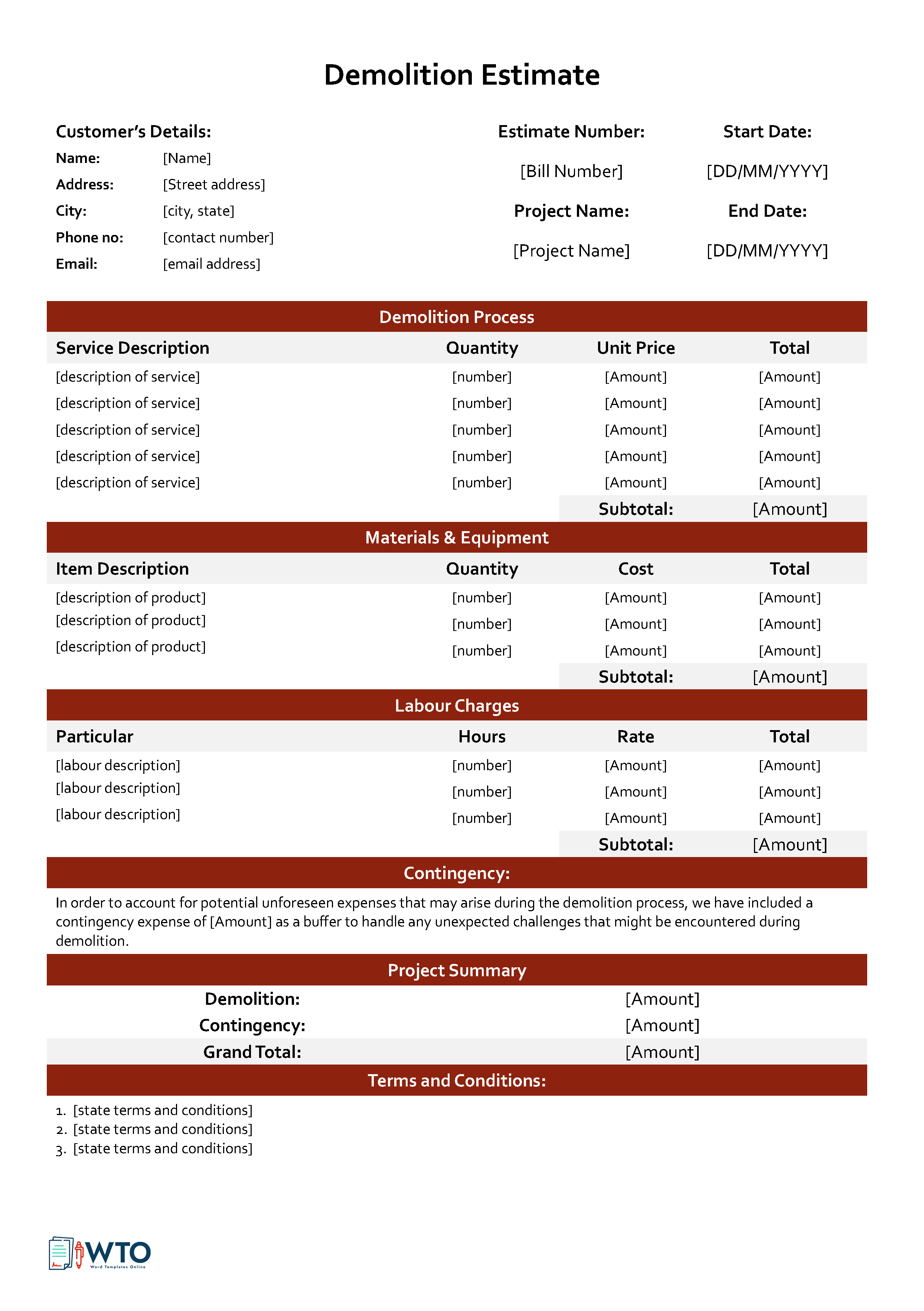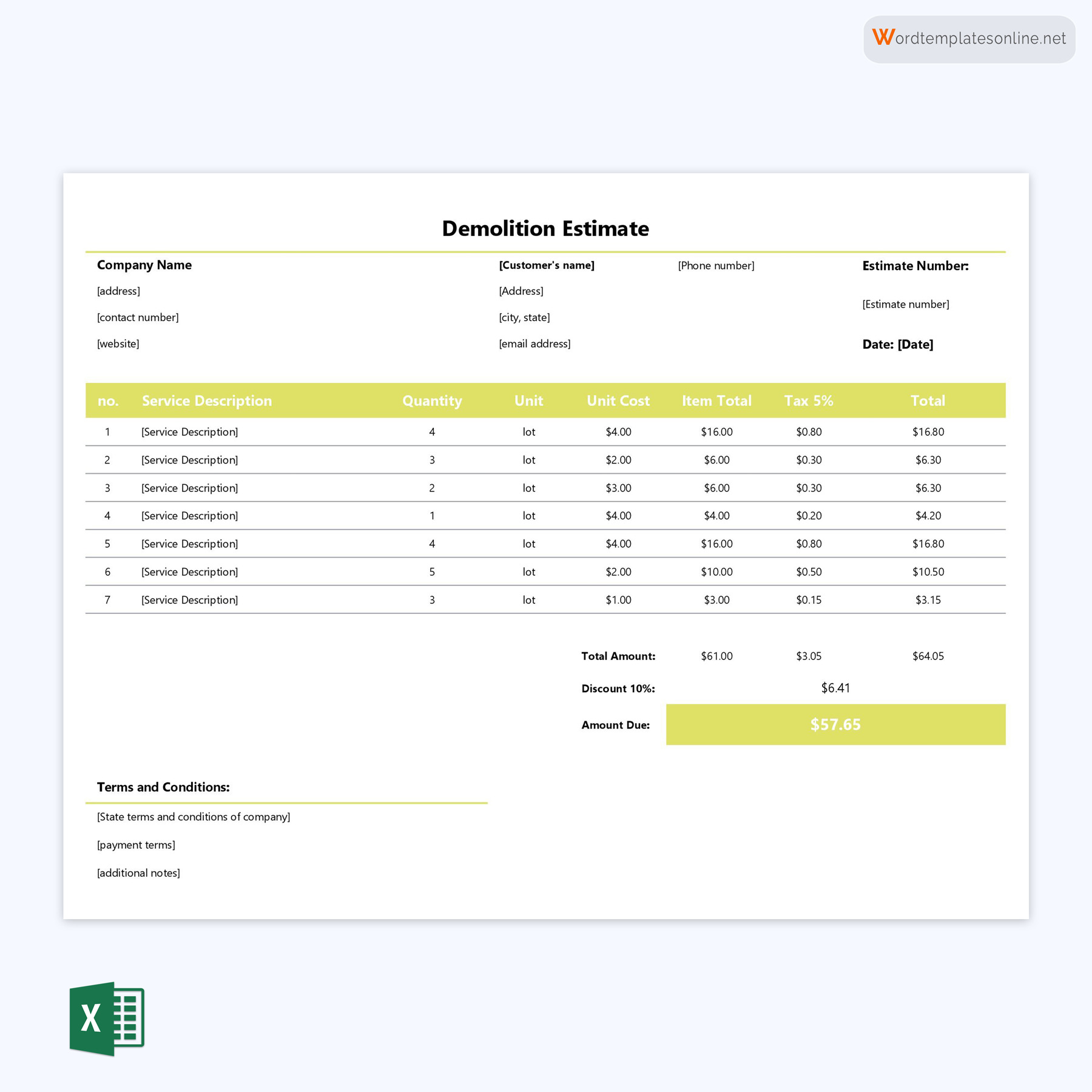A demolition estimate template is a pre-formatted document or spreadsheet that contractors and other construction professionals commonly used to estimate the costs associated with a demolition project.
It presents a structured format for outlining the scope of work, required materials, and equipment. The template also has fields for itemizing various costs, such as labor costs, permit and disposal fees, additional expenses, and contingency fees. It also contains features that allow for easy cost calculation, providing a concise breakdown of the estimated expenses to the client or project owner.
Drafting an accurate estimate is a significant step in the process. It helps you determine the exact cost of undertaking a project. This allows you to develop an effective and practical budget to avoid unforeseen expenses. An accurate estimate provides a clear understanding of the scope and timeline of the demolition project, giving you the room to plan your resources, workforce, and equipment accordingly.
It also gives you a competitive advantage if other organizations are bidding for the same project, showcasing your professionalism and commitment to quality service. Since the project involves inherent risks, an accurate estimate can help you identify potential risks and develop appropriate mitigation strategies. This ensures the safety of workers, nearby structures, and the surrounding environment. A well-structured estimate ensures you execute the project efficiently and within budget and financial constraints.
In this article, we will go through the benefits of using a template for a demolition estimate, when to use it, and what it contains. Free printable templates have also been provided in Excel spreadsheet format, along with samples and examples for your convenience.
Benefits of Using a Demolition Estimate Template
Using a template to create a demolition estimate accords you several benefits, including:
Streamlined estimation process
The template has predefined headings, sections, and categories that allow you to present the information in an organized manner. With a pre-structured framework, you can save time and effort since you do not have to create a new estimate from scratch every time you are bidding for a demolition project, allowing you to focus on service delivery. You can simply modify and customize the existing template to suit the specific requirements of each project.
Accurate cost breakdown
Since it has built-in formulas, a template can help minimize the chances of errors when calculating labor, permit, handling, and contingency costs. It also has dedicated fields to outline the scope of work, materials, and equipment required. These elements ensure that you draft a comprehensive estimate that accurately captures the costs of undertaking such a project.
Customization of project-specific requirements
Even though the template provides a structured framework for estimation, it is also flexible enough to be tailored to the specific needs of each project. It can be easily modified to include project-specific aspects, such as tasks or materials, equipment, and personnel requirements. It may also be modified to accommodate regional factors, industry regulations, or current market rates. Customization ensures the template captures every aspect of the project and its unique requirements.
Consistency and professionalism
Using a template with a standardized format ensures all your estimates are presented in a consistent, visually appealing format. This makes it easy to understand and helps build a professional image for your organization. A well-designed template also demonstrates your attention to detail during the estimation process, establishing your efficiency in project management.
Enhanced project planning and decision-making
The template has predefined fields that allow you to provide a comprehensive breakdown of the costs associated with the project. Therefore, you can conduct a thorough cost analysis to make informed, data-driven budgeting and resource allocation decisions. This allows you to assess the project’s viability and identify potential cost-saving opportunities to allocate resources and personnel more efficiently.
Documentation and record-keeping
With a template, you can easily document estimates that can be retrieved for auditing, client presentations, and future reference purposes. You can easily keep track of estimates and compare quoted prices with actual project costs. You can use this information to analyze your estimation procedures to improve accuracy when estimating future projects.
When Should You Use a Demolition Estimate Template?
You should utilize a template for an estimate during various stages of the project. Discussed below are instances when the template is beneficial:
Pre-project planning stage
During the initial planning phase of a project, you may use a template to assess its feasibility and financial viability. You can outline the estimated costs, required resources, and project timelines. This gives you a clear understanding of the project scope and its financial implications, giving you the data you need to decide whether to move forward with it or not.
Budgeting and financial planning
Throughout the project’s execution, the template serves as a reference point for budgeting and financial planning. It allows you to track project-related expenses such as material, equipment, permits, disposal, and labor costs against the estimated costs. You can therefore forecast and allocate funds more efficiently to ensure the project stays within budget.
Proposal and bidding process
When bidding for a project, a template can help you generate a detailed, professional-looking estimate to present to a potential client. It allows you to submit an accurate, comprehensive breakdown of costs in a structured manner, demonstrating your transparency and credibility. It streamlines the bidding process and gives you a competitive advantage over other organizations bidding for the same project.
Project execution and monitoring
During the course of project execution, a template can be a valuable tool to compare estimated costs against actual project costs. This continuous monitoring allows for effective budgeting and cost control, ensuring the cost of executing the project does not exceed the intended budget. If there are modifications or additions to the project scope, you can easily edit the template to create a revised estimate. This provides real-time insights into the financial impact of the project.
Components of a Demolition Estimate Template
The template typically contains the following key elements:
Project information
The first section of the template is a field to record client information, project name, project location, date of the estimate, and estimate number. This information is crucial for reference and identification purposes.
Project timeline
In this section, you can record the estimated start and end dates of the project. This timeline allows you to plan accordingly and gives the client an idea of how long the project will take.
Scope of work
The template has a field in which you can provide a detailed description of the tasks involved with the project. You can mention the structural elements to be demolished, such as floors, walls, roofs, or other building structures. Moreover, you may also specify the type of demolition to be conducted and the equipment to be used. Furthermore, you may specify site clearance requirements and a description of how the debris will be disposed of. This breakdown ensures every aspect of the demolition is accounted for.
Materials and equipment
In this section of the template, you can list the equipment required for the project, such as excavators, earthmovers, loaders, and other demolition-specific machinery. It also includes a table for materials necessary for the demolition, their cost, quantities required, and total cost. These materials include safety equipment, debris containers, and specialized tools.
Labor and manpower
The template has fields for listing the number of specialized workers required, their hourly rates, and the total estimated cost. The scope of work should also be considered when evaluating the labor costs for the project.
Hazardous material handling
In this field, you can detail the costs associated with handling hazardous debris. You may also describe how the material will be removed, disposed of, and recycled. Factors such as testing, abatement, and regulatory compliance should be considered when estimating these costs.
Cost of disposal
The template has a section detailing the costs of debris disposal. These include expenses such as hauling and landfill fees. By including this information, you demonstrate your commitment to responsible waste management. It also showcases your transparency to your clients by assuring them that the debris will be disposed of accordingly.
Permits and regulations
In this section, you can outline the costs of obtaining the permits required for demolition. You can also include the permit fees and other costs, such as inspection and compliance fees. This ensures every legal aspect of the project is taken into consideration.
Contingency and miscellaneous expenses
The template includes a field to account for unforeseen costs that may arise during the project. It can be expressed as a percentage of the total amount or as a fixed fee dedicated to additional labor, equipment, or material needs. This provides a cushion to avoid overspending should the project run into challenges.
Cost of disconnecting utilities
Should you need to disconnect utilities such as water, gas, or electricity before demolition, you can indicate the estimated costs for disconnection in this section of the template. This ensures your client understands which utilities will be secured before demolition.
Total cost calculation and summary
This section sums up all the costs of materials, labor, equipment, waste disposal, permits, and contingency costs to provide an aggregate estimated cost for demolition. This gives the client a clear summary of the estimated cost for reference during the bidding process.
Payment terms
In the final section, there is a field to outline the terms and conditions associated with the execution of the project. These include acceptance terms, payment terms, warranties, insurance, and change order policies. Including these terms ensures your client is aware of their obligations should they accept the estimate.
Free Templates
Given below are demolition estimate templates:


Estimate Vs. Quote
A demolition estimate is an approximation of the expected costs associated with a demolition project, usually provided in the planning phase. It details the expenses involved based on available project details, such as the size of the structure, location, complexity, and other relevant factors. This is a rough estimation of the potential expenses a project manager or property owner can expect to pay for these services. It is important to note that an estimate is not a legally binding agreement, and the final cost may vary based on the actual work done and any unexpected circumstances encountered during the course of executing the project.
On the other hand, a demolition quote is a formal offer provided by a contractor to a client to undertake a project at a specific price. Also referred to as a demolition bid or proposal, it outlines the scope of work, materials and equipment required, labor costs, disposal and permit fees, and any other expenses associated with the project. Unlike an estimate, a quote is a more detailed presentation of the actual cost and is legally binding once accepted by the client. It serves as a contractual agreement between the client and the contractor, providing a clear understanding of what services will be offered and at what cost.
In a Nutshell
Using a template for an estimate can significantly streamline the project estimation process. A template ensures you capture every cost associated with the demolition, allowing you to furnish your client with a comprehensive estimate. A template not only saves you time and effort but also ensures reliability and consistency.
The template can also be modified to fit specific project requirements, allowing you to efficiently communicate the costs associated with a project to potential clients. Whether the project is a small residential demolition or a large-scale commercial project, using a template can enhance accuracy and ultimately contribute to its success. Choose a template best suited to your needs, download it, and fill in the required details.









